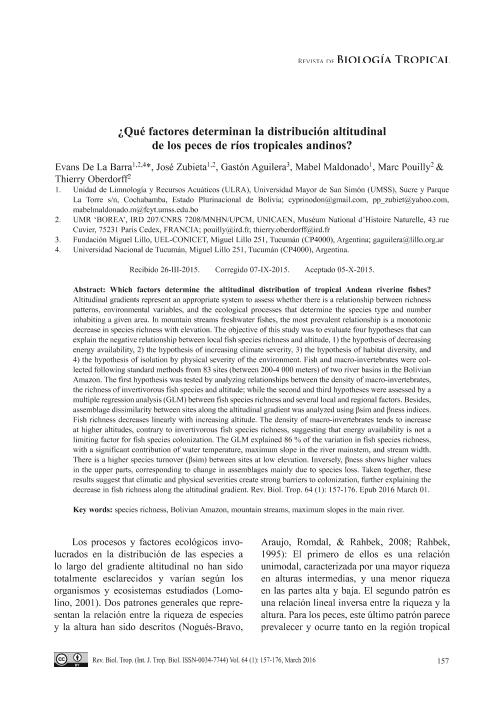Mostrar el registro sencillo del ítem
dc.contributor.author
De la Barra, Evans
dc.contributor.author
Zubieta, José
dc.contributor.author
Aguilera, Gaston

dc.contributor.author
Maldonado. Mabel
dc.contributor.author
Pouilly, Marc

dc.contributor.author
Overdoff, Thierry
dc.date.available
2018-08-28T18:49:22Z
dc.date.issued
2016-03
dc.identifier.citation
De la Barra, Evans; Zubieta, José; Aguilera, Gaston; Maldonado. Mabel; Pouilly, Marc; et al.; ¿Qué factores determinan la distribución altitudinal de los peces de ríos tropicales andinos?; Revista de Biología Tropical; Revista de Biología Tropical; 64; 1; 3-2016; 157-176
dc.identifier.issn
0034-7744
dc.identifier.uri
http://hdl.handle.net/11336/57393
dc.description.abstract
Altitudinal gradients represent an appropriate system to assess whether there is a relationship between richness patterns, environmental variables, and the ecological processes that determine the species type and number inhabiting a given area. In mountain streams freshwater fishes, the most prevalent relationship is a monotonic decrease in species richness with elevation. The objective of this study was to evaluate four hypotheses that can explain the negative relationship between local fish species richness and altitude, 1) the hypothesis of decreasing energy availability, 2) the hypothesis of increasing climate severity, 3) the hypothesis of habitat diversity, and 4) the hypothesis of isolation by physical severity of the environment. Fish and macro-invertebrates were collected following standard methods from 83 sites (between 200-4 000 meters) of two river basins in the Bolivian Amazon. The first hypothesis was tested by analyzing relationships between the density of macro-invertebrates, the richness of invertivorous fish species and altitude; while the second and third hypotheses were assessed by a multiple regression analysis (GLM) between fish species richness and several local and regional factors. Besides, assemblage dissimilarity between sites along the altitudinal gradient was analyzed using βsim and βness indices. Fish richness decreases linearly with increasing altitude. The density of macro-invertebrates tends to increase at higher altitudes, contrary to invertivorous fish species richness, suggesting that energy availability is not a limiting factor for fish species colonization. The GLM explained 86% of the variation in fish species richness, with a significant contribution of water temperature, maximum slope in the river mainstem, and stream width. There is a higher species turnover (βsim) between sites at low elevation. Inversely, βness shows higher values in the upper parts, corresponding to change in assemblages mainly due to species loss. Taken together, these results suggest that climatic and physical severities create strong barriers to colonization, further explaining the decrease in fish richness along the altitudinal gradient.
dc.format
application/pdf
dc.language.iso
spa
dc.publisher
Revista de Biología Tropical

dc.rights
info:eu-repo/semantics/openAccess
dc.rights.uri
https://creativecommons.org/licenses/by-nc-sa/2.5/ar/
dc.subject
Species Richness
dc.subject
Bolivian Amazon
dc.subject
Mountain Streams
dc.subject
Maximun Slopes
dc.subject.classification
Otras Ciencias Biológicas

dc.subject.classification
Ciencias Biológicas

dc.subject.classification
CIENCIAS NATURALES Y EXACTAS

dc.title
¿Qué factores determinan la distribución altitudinal de los peces de ríos tropicales andinos?
dc.title
Which factors determine the altitudinal distribution of tropical Andean riverine fishes?
dc.type
info:eu-repo/semantics/article
dc.type
info:ar-repo/semantics/artículo
dc.type
info:eu-repo/semantics/publishedVersion
dc.date.updated
2018-08-17T16:55:53Z
dc.journal.volume
64
dc.journal.number
1
dc.journal.pagination
157-176
dc.journal.pais
Costa Rica

dc.journal.ciudad
Turrialba
dc.description.fil
Fil: De la Barra, Evans. Universidad Mayor de San Simon; Bolivia. Museum National d'Histoire Naturelle; Francia. Universidad Nacional de Tucumán; Argentina
dc.description.fil
Fil: Zubieta, José. Universidad Mayor de San Simon; Bolivia. Museum National d'Histoire Naturelle; Francia
dc.description.fil
Fil: Aguilera, Gaston. Consejo Nacional de Investigaciones Científicas y Técnicas. Centro Científico Tecnológico - Tucumán. Unidad Ejecutora Lillo; Argentina
dc.description.fil
Fil: Maldonado. Mabel. Universidad Mayor de San Simon; Bolivia
dc.description.fil
Fil: Pouilly, Marc. Museum National D'histoire Naturelle. Institut de Recherche Pour Le Developpment; Francia
dc.description.fil
Fil: Overdoff, Thierry. Museum National D'histoire Naturelle. Institut de Recherche Pour Le Developpment; Francia
dc.journal.title
Revista de Biología Tropical

dc.relation.alternativeid
info:eu-repo/semantics/altIdentifier/url/https://revistas.ucr.ac.cr/index.php/rbt/article/view/18576
dc.relation.alternativeid
info:eu-repo/semantics/altIdentifier/url/http://www.redalyc.org/articulo.oa?id=44943437015
dc.relation.alternativeid
info:eu-repo/semantics/altIdentifier/doi/http://dx.doi.org/10.15517/rbt.v64i1.18576
Archivos asociados
